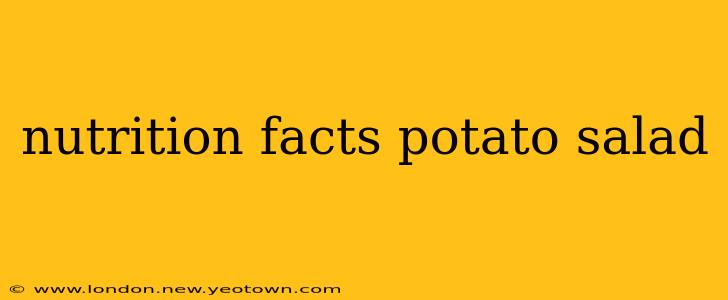Decoding the Delicious: A Deep Dive into Potato Salad Nutrition
Potato salad. The quintessential summer picnic side dish, the comforting friend at backyard barbecues, the creamy counterpoint to juicy burgers. But have you ever stopped to consider exactly what you're eating when you scoop up a generous helping? Let's peel back the layers (pun intended!) and explore the often-overlooked nutrition facts of potato salad.
What are the typical ingredients in potato salad?
The beauty (and sometimes the downfall) of potato salad lies in its versatility. Recipes vary wildly, but most commonly include boiled potatoes, mayonnaise, celery, onion, hard-boiled eggs, and seasonings like mustard, salt, and pepper. Variations often incorporate relish, pickles, bacon, or even different herbs and spices. This wide range of ingredients significantly influences the final nutritional profile.
How many calories are in a typical serving of potato salad?
This is where things get a little tricky. A single serving size (usually around ½ cup) can range anywhere from 150 to 300 calories, depending heavily on the recipe. A creamy, mayonnaise-heavy potato salad will naturally pack more calories than a lighter version made with a vinaigrette or reduced-fat mayonnaise. The addition of bacon or other high-calorie ingredients will further increase the calorie count.
What are the macronutrients (carbs, fats, protein) in potato salad?
The macronutrient breakdown is similarly variable. Potatoes themselves are a good source of carbohydrates, providing energy. The mayonnaise contributes significantly to the fat content, primarily unsaturated fats, although the type of mayonnaise used (e.g., regular, light, avocado oil) makes a difference. The eggs and, to a lesser extent, the celery and onions, add some protein to the mix. A typical serving might contain roughly 20-40 grams of carbohydrates, 10-20 grams of fat, and 3-7 grams of protein. However, these numbers are estimates and can fluctuate dramatically.
Is potato salad healthy? Can it be part of a healthy diet?
The "healthy" label for potato salad is definitely a matter of degree. In moderation, and with mindful ingredient choices, potato salad can absolutely be part of a balanced diet. Opting for a recipe with reduced-fat mayonnaise, using plenty of vegetables, and limiting high-calorie additions like bacon can significantly improve the nutritional profile. Consider adding healthy fats like avocado oil to the mayonnaise for heart-healthy benefits, and focus on using fresh, high-quality ingredients.
What are the vitamins and minerals in potato salad?
While not a powerhouse of nutrients, potato salad does offer some vitamins and minerals. Potatoes are a decent source of vitamin C and potassium. Eggs contribute choline and selenium, vital for brain health and antioxidant protection. The vegetables add small amounts of various vitamins and minerals depending on their specific types and quantities.
How can I make healthier potato salad?
Making healthier potato salad doesn’t mean sacrificing flavor! Experiment with these simple swaps:
- Reduce the mayonnaise: Use Greek yogurt or a combination of Greek yogurt and mayonnaise to reduce the fat and calorie content.
- Boost the veggies: Add more colorful vegetables like bell peppers, carrots, or cucumbers to increase the nutrient density.
- Choose healthier fats: Use avocado oil mayonnaise or a light olive oil and lemon juice dressing instead of full-fat mayonnaise.
- Go easy on the salt: Season with herbs and spices instead of relying heavily on salt.
By understanding the nutritional components and making smart substitutions, you can enjoy potato salad without sacrificing your health goals. Remember, moderation and mindful ingredient choices are key to enjoying this classic dish as part of a balanced diet.

